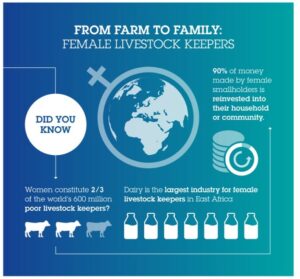Are Healthy Animals the Key to a Healthy World?
Imagine a world without animals. Heck, just imagine the upcoming holidays without them.
No ham, turkey or beef brisket as part of the traditional holiday meal, no family dog at your feet as you attempt to make your grandma’s famous dinner rolls, no cat curled up on your lap as you read a good book after the kitchen’s spiffed up and extended family head back home.
Between providing nourishment, companionship, emotional support, livelihoods, entertainment and more, animals make our lives better in so many ways. You might be surprised at the vital role they play in reaching ambitious global sustainability goals, too.
In 2015, the United Nations adopted a blueprint to achieve a better and more sustainable future for all – with an aggressive timeline to reach milestones by 2030. At the core are 17 Sustainable Development Goals (SDGs), which are an urgent call for action by all countries – developed and developing – to address global challenges.
Many of these goals can be seen through the lens of One Health – a collaborative approach including doctors, nurses, veterinarians and other health- and environment-related disciplines around the globe aimed at improving the world’s overall health.
One Health recognizes the intricate connection between the health of people, animals and the environment in reaching SDGs. It’s definitely a balancing act. Where you change one, you impact the others.
As a veterinarian, I’m keenly aware of healthy animals’ role in achieving the UN’s sustainability outcomes and incredibly thankful that veterinarians around the world have tools in their toolbox like vaccinations and antibiotics that help treat and eradicate disease, prevent animal suffering and give farmers – particularly in underdeveloped and developing countries – a way to make a living, provide nutritious protein for their families and communities, and support their local economies.
As we look at just three of the 17 SDGs, you can see how the contribution of healthy animals is truly transformative.
No Poverty
The number one SDG is to “end poverty in all its forms everywhere.” A tall order in a short timeframe. But healthy animals can help us get there.
We’re incredibly fortunate to live in a country where abundance abounds. Poverty, while found in pockets of the U.S., is not the kind of dire poverty found in many underdeveloped and developing regions.
While we may experience a few bare shelves due to pandemic-related supply chain challenges, there are many places beyond our borders where bare shelves, hunger, and starvation are daily realities.
In those parts of the world, animals raised for food are an essential driver of economic growth. Consider that over 1 billion people rely on livestock to not only put food on the table, but also to make a living. Put another way, one in six people worldwide are employed in livestock production. Their livelihood depends on their animals’ health.
Providing more access and opportunities to raise livestock means increased incomes so families can be more productive, have access to better healthcare and education, contribute to savings and investments for the future, and spend money in their communities to help them flourish.
Animals truly are a safety net for many families as evidenced by one initiative launched in June 2016.
The brainchild of philanthropist Bill Gates, this project helps poor families in sub-Saharan Africa by giving them vaccinated chickens. Gates said raising and selling the vaccinated birds can tackle poverty and help rural families raise improved breeds of chickens, protected from disease. A farmer breeding five hens can earn more than $1,000 (U.S), and with nearly 400 million people in Sub-Saharan African living on less than $700 a year (U.S.), this is a life changer.
Zero Hunger
The second SDG is achieving zero hunger.
You’ve likely heard that the global population is expected to reach over 9 billion by 2050. It’s like adding the entire population of Africa to our world – twice. That’s a lot of mouths to feed and meat, milk and eggs are vital to providing nutritious protein to families everywhere.
According to the World Food Programme, 155 million people in 55 countries experienced acute hunger requiring urgent food assistance in 2020. Today, about 1 billion people don’t have sufficient food consumption in low and lower-middle income countries. The pandemic is driving numbers higher.
With more people in need of high-quality protein, I’m grateful for advancements that allow farmers around the world to raise animals more sustainably and for significant innovations such as vaccinations, better animal nutrition, and improved breeding, to keep up with growing demands.
In developing regions, a single animal can provide food for a family, manure for their plants and labor to help till the field. It can also provide an income that allows them to buy more fruits, vegetables and grains for improved nutrition and a well-rounded diet.
Decent Work and Economic Growth
The eighth SDG is promoting sustained, inclusive and sustainable economic growth, full and productive employment, and decent work for all.
How do healthy animals help us achieve this goal? Let’s look at gender inequities in underdeveloped and developing regions and how providing greater opportunities to women farmers can empower them, and better their families and communities. 
About 90 percent of the world’s 570 million farms are small, according to the Food and Agriculture Organization (FAO) of the United Nations. Most are found in the rural areas of the developing world, and are owned and operated by families. Many of these smallholder family farmers are poor, food insecure and have limited access to markets and services. And most of these farms are run by women.
While exact data is difficult to come by, it’s estimated that women make up 60 to 80 percent of farmers in non-industrialized countries. Specifically, women make up two-thirds of the world’s livestock keepers.
But they face inequities and obstacles, including access to credit to purchase livestock, equipment, and land. While they may manage farms, they may not own them as traditions in some countries mean land is passed down through the male side of the family. Women sometimes are not as productive due to a lack of education. When education is considered more valuable for men, women farmers are less informed about the best ways to raise animals and grow food.
Opening doors for women is key and that includes continued opportunities to raise livestock. We saw above with the initiative launched by Bill gates just how impactful it can be. As few as five healthy hens can result in a greatly increased and reliable income.
As moms and household managers, when women have increased income and productive assets like land and animals, the entire family benefits. They eat better quality food, family health improves and moms can afford to send their daughters to school to live more productive lives – breaking a cultural cycle where education is often reserved for boys.
On the Right Path
With the UN Sustainability Development Goals front and center for countries around the world, we’re on the right path to tackle serious challenges by the end of this decade. But we can’t get there without continued efforts and innovation in keeping the animals that nourish us and sustain livelihoods healthy.
While we ponder what our holidays might look like without animals, consider what life for families in some countries would hold – where small herds of dairy cattle are wiped out by disease, for example. The impact would be dramatic, and frankly, dire.
But I’m optimistic. I see the advances we continue to make in animal health and I’m excited that through the UN and initiatives like One Health, countries around the world recognize animals’ contribution to healthier people and a healthier planet.
Did you know healthy animals have a lower carbon footprint? In my next blog, we’ll look at how animal health plays a part in SDGs regarding sustainable production and tackling climate change.
Graphics Source: HealthForAnimals.org and sdgs.un.org/goals
Photo source: Pixabay
